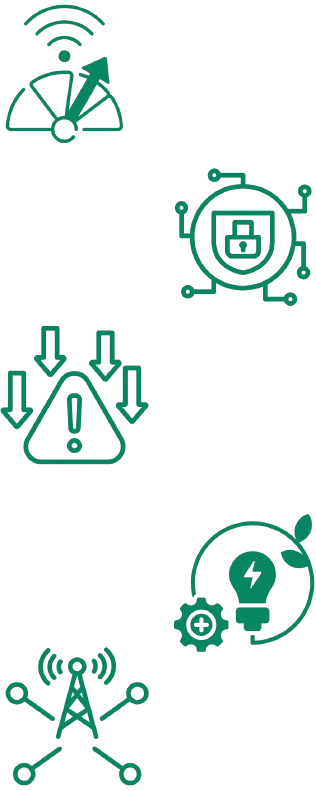What is LiFi?
LiFi, or Light Fidelity Technology, is an advanced wireless technology that uses visible light to transfer data. Unlike WiFi, which uses radio waves, LiFi uses LED light signals and photodetectors to deliver fast data speeds.

Wireless communication is an essential part of daily life, helping us work, connect, and enjoy entertainment. From watching shows to controlling smart devices, technologies like WiFi have changed how we interact with the digital world. Now, there’s a new technology called LiFi.
LiFi (Light Fidelity) internet is an innovative technology that uses light to send data at much higher speeds.
LiFi, or Light Fidelity Technology, is an advanced wireless technology that uses visible light to transfer data. Unlike WiFi, which uses radio waves, LiFi uses LED light signals and photodetectors to deliver fast data speeds.

By leveraging light as a medium, LiFi internet can achieve unparalleled speeds and efficiency compared to traditional wireless technologies.
| Aspect | LiFi | Bluetooth |
|---|---|---|
Technology Used | Uses light (LEDs) to send data. | Uses radio waves to send data. |
Speed | Much faster, up to 100 times quicker. | Slower compared to LiFi. |
Range | Shorter range, needs direct line of sight. | Can cover longer distances. |
Security | More secure, data is harder to intercept. | Less secure, data can be more easily intercepted. |
Energy Consumption | Uses less power. | Uses more power than LiFi. |
Applications | Great for homes, offices, and hospitals. | Used in devices like phones and headsets. |
When comparing LiFi vs Bluetooth, LiFi offers much faster speeds and more secure communication because it uses light, while Bluetooth uses radio waves. LiFi also consumes less power and is ideal for areas that need high-speed data, like hospitals or smart homes. Bluetooth, however, works well for devices like phones, headphones, and other gadgets over longer distances.
The future of LiFi will involve closer integration with next-generation networks like 6G. We can also expect hybrid systems that combine the strengths of both LiFi and WiFi, offering the best of both technologies.
For LiFi to become widely used, there will need to be a big investment in infrastructure and global standards. While LiFi internet may first be adopted for specific use cases, it’s expected to be more widely used as the technology develops.
Research is being done to solve problems like needing a clear line-of-sight and interference from surrounding light. These fixes will help make LiFi a more common technology.
LiFi has the potential to transform industries, from telecommunications and transportation to building smarter cities. Business and IT professionals should watch its progress closely – it could soon become an important part of your industry.
With the rise of LiFi networks, the way we connect to the internet will change. LiFi networks are expected to become a big part of smart cities, making everything from traffic lights to medical devices smarter and more efficient.

LiFi is much faster than WiFi, with data transfer speeds that could greatly improve internet performance in homes, offices, and public spaces.
LiFi Internet is more secure for transmitting sensitive data because light can’t pass through walls, making it ideal for places like hospitals or government buildings.
LiFi uses light, which reduces interference from other devices that often affect WiFi. This makes it perfect for places where electronic interference is a problem.
LiFi uses energy-efficient LED lights for both lighting and data transmission, which could result in big energy savings, especially in businesses and industries.
WiFi can cover up to 30 meters indoors and even more outdoors. LiFi has a shorter range, limited to the area where the light shines, usually just one room.
LiFi internet is a new wireless technology that uses light instead of radio waves like WiFi. It offers faster speeds, better security, and more efficiency. LiFi could transform how we connect in places like hospitals, smart homes, planes, and underwater. As it develops, LiFi will work with WiFi to improve how we share information, potentially changing communication in the near future.
| Cookie | Duration | Description |
|---|---|---|
| cookielawinfo-checkbox-analytics | 11 months | This cookie is set by GDPR Cookie Consent plugin. The cookie is used to store the user consent for the cookies in the category "Analytics". |
| cookielawinfo-checkbox-functional | 11 months | The cookie is set by GDPR cookie consent to record the user consent for the cookies in the category "Functional". |
| cookielawinfo-checkbox-necessary | 11 months | This cookie is set by GDPR Cookie Consent plugin. The cookies is used to store the user consent for the cookies in the category "Necessary". |
| cookielawinfo-checkbox-others | 11 months | This cookie is set by GDPR Cookie Consent plugin. The cookie is used to store the user consent for the cookies in the category "Other. |
| cookielawinfo-checkbox-performance | 11 months | This cookie is set by GDPR Cookie Consent plugin. The cookie is used to store the user consent for the cookies in the category "Performance". |
| viewed_cookie_policy | 11 months | The cookie is set by the GDPR Cookie Consent plugin and is used to store whether or not user has consented to the use of cookies. It does not store any personal data. |